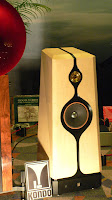 The Music of Patti Smith
CD Recommendation: Pop
Letter from NYC (59) 2016 (15)
The Music of Patti Smith
CD Recommendation: Pop
Letter from NYC (59) 2016 (15)
-
Patti Smith Official Site
-Detailed
Wikipedia Entry
-
How Does It Feel Patti Smith writes in the New Yorker after singing to honor Bob Dylan in the 2016 Nobel ceremony
Patti Smith, as much of an artist as she is, is actually not very well known (certainly not in audiophile circles, where I have never heard her CD's). Most who have heard her name does not really know her works, be it music or writings.
It was poetry that brought Patti Smith to Rock. The music started as something to add texture to her poetry recitals (including at St Mark's Church). If one does not read her lyrics, which are poems, one does not know just how great they are. If you ask me, her more elliptical way with words is as worthy of the Nobel as Bob Dylan.


In my youth, I had listened to her most famous album,
Horses, but didn't take to its sharp edge, and none of the songs had a good hook. It was not until this year that my interest in her was revived by her books
Just Kids and
M Train, both masterpieces, the former a recipient of the National Book Award. I read a lot about her and bought a few of her CD's. This time in NYC, I went through them all.
Early Works The sharp edge of both
Horses (1975) and
Easter (1978) still can be grating, but this time, more than thirty years since I heard the former, as a vastly more experienced listener and admirer of her prose I paid a lot of attention to the lyrics, evaluated them as a whole and found a lot more. While these albums certainly will not make comfortable background listening and not recommendable for most audiophiles, they are very layered and rewarding in the long term. Even this time, the first round of listening still unsettled me a little. It was done on the living room's Linn system, with Lin Kan loudspeakers. After I swapped the Linn Kan's out for the JBL L20T (
here), the albums just became much more listenable. So a warmer and heftier sound would suit these albums.
 Late Works
Late Works Smith's late works are understandably completely different from her early works, but neither are they in the same mould.
Gone Again (1996), written after the death of her husband, is mostly elegiac and strangely beautiful.
Banga (2012), her latest album, is made of lighter material, atmospheric and, for lack of a better word, poetic. I can imagine an ECM lover liking this album - why not, as it has just as much atmosphere, but much more depth! A sleeper is
Twelve (2007), a covers album that serves to illuminate the fact that Smith is an excellent singer. As on all these albums, she knows how to modulate her voice to achieve various shades of emotions.
All three of these CD's have excellent sound.
Patti Smith was inducted into the Rock and Roll Hall of Fame in 2007. Read the above wiki entry for her numerous other awards for her contribution in the arts and her humanitarian efforts. She ranks 47 in
Rollingstone 100 Greatest Artist list (a great read as it was written by musicians and people in the industry, with contributions by many famous names).
After reading her prose and hearing these CD's, I worship her. It would be hard to find another more unassuming person of greater accomplishment in the arts. There are prettier and more glamorous stars, but few more beautiful people. Perhaps I write this to say Happy New Year to Patti Smith!
Something that has nothing to do with this article: I chanced upon this Jennifer Warnes Interview that is about another of my heroes, Leonard Cohen.









:format(jpeg):mode_rgb():quality(40)/discogs-images/R-1747742-1240777410.jpeg.jpg)

